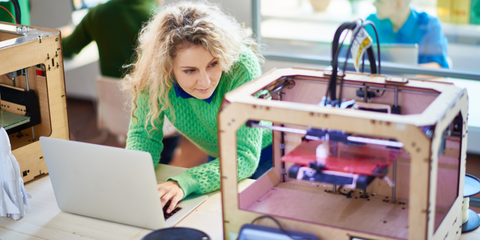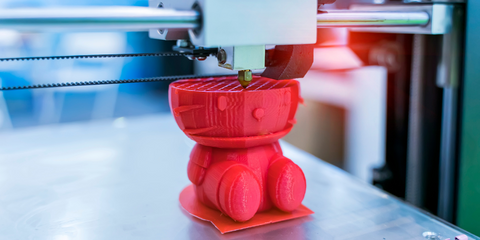Introduction:
Vector graphics and 3D printing are two technologies that have revolutionized the way we design and create products. Vector graphics are a type of digital image that is made up of mathematical equations, rather than pixels, making them scalable and easy to edit. On the other hand, 3D printing is a method of creating physical objects from digital models, using materials such as plastic, metal, and resin. In this article, we will explore the role of vector graphics in the world of 3D printing, including the process of converting vector graphics into 3D models and the benefits of using vector graphics in 3D printing.
The Basics of Vector Graphics:

Vector graphics are a type of digital image that is created using mathematical equations, rather than pixels. The main advantage of vector graphics is that they are scalable, meaning that they can be enlarged or reduced without losing any quality. This makes them ideal for use in a variety of contexts, such as logos, illustrations, and architectural plans.
There are several types of vector graphics formats, including SVG, AI, and EPS. SVG, or Scalable Vector Graphics, is a type of vector graphics that is optimized for use on the web. AI, or Adobe Illustrator, is a proprietary format that is commonly used in the design industry. EPS, or Encapsulated PostScript, is a format that is often used for printing.
Vector graphics can be created and edited using software such as Adobe Illustrator, CorelDRAW, and Inkscape. These programs allow users to create and manipulate vector graphics using a variety of tools and features, such as paths, shapes, and text.
How Vector Graphics are used in 3D Printing:
Vector graphics are an important part of the 3D printing process, as they are used to create digital models that can be printed into physical objects. The process of converting vector graphics into 3D models typically involves using software such as Autodesk Fusion 360 or Rhino3D. These programs allow users to import vector graphics and manipulate them to create 3D models with accurate dimensions and details.
One of the main benefits of using vector graphics in 3D printing is the ability to easily edit and scale designs. Because vector graphics are made up of mathematical equations, they can be easily modified and resized without losing any quality. This is particularly useful for creating multiple versions of a product or for making adjustments to a design during the prototyping stage.
Another benefit of using vector graphics in 3D printing is the ability to create highly detailed and accurate models. Vector graphics can be used to create 3D models with intricate features, such as curved surfaces and complex shapes, that would be difficult or impossible to create using other methods.
In summary, using vector graphics in 3D printing allows to create highly detailed and accurate models, with the ability to easily edit and scale designs.
Case Studies:

Architecture: Vector graphics are commonly used in the architecture industry to create detailed and accurate models of buildings and structures. For example, architects can use vector graphics to create 3D models of floor plans, elevations, and sections. These models can then be 3D printed to create physical models that can be used for presentations, client meetings, and site visits.
Jewelry: Vector graphics are also used in the jewelry industry to create intricate and detailed designs. For example, a jewelry designer can use vector graphics to create a 3D model of a ring, which can then be 3D printed in gold, silver, or other precious metals. This allows for accurate prototyping and testing of designs before they are produced at scale.
Product Prototyping: Vector graphics can also be used in the product design industry to create accurate and detailed prototypes of products. For example, a product designer can use vector graphics to create a 3D model of a new product, which can then be 3D printed to create a physical prototype that can be tested and refined before it is manufactured.
In conclusion, vector graphics are a versatile technology that can be used in a variety of industries and for a variety of purposes, including architecture, jewelry, and product prototyping. These examples demonstrate the ability of vector graphics to create accurate, detailed and high-quality models that can be 3D printed.
Conclusion:

In this article, we have explored the role of vector graphics in the world of 3D printing. We have seen that vector graphics are a type of digital image that is created using mathematical equations, making them scalable and easy to edit. We have also seen how vector graphics are used to create digital models that can be printed into physical objects, using software such as Autodesk Fusion 360 and Rhino3D.
We have also discussed the benefits of using vector graphics in 3D printing, such as the ability to easily edit and scale designs and the ability to create highly detailed and accurate models. We have also provided some examples of real-world applications of vector graphics in 3D printing, such as architectural models, jewelry, and product prototyping.
In conclusion, vector graphics are an important technology in the world of 3D printing. They allow for the creation of accurate, detailed, and high-quality models that can be easily edited and scaled. If you are interested in using vector graphics in your own 3D printing projects, there are many resources and tutorials available online to help you get started.
Additional Resources: If you are interested in learning more about the use of vector graphics in 3D printing, there are many resources available online. Websites such as Shapeways and Thingiverse offer tutorials and tips for converting vector graphics into 3D models. Additionally, many software companies such as Autodesk and Rhino3D have online communities and forums where users can share tips and ask for advice.
Online Courses: If you want to take your learning to the next level, there are many online courses available that cover the use of vector graphics in 3D printing. For example, websites such as Udemy and Coursera offer courses that cover topics such as 3D modeling and 3D printing.
Practice: As with any new skill, the more you practice, the better you will become. Try experimenting with different vector graphics software and 3D printing techniques to get a better understanding of how they work together. Additionally, try to take on projects that challenge you and push you to learn new things.




